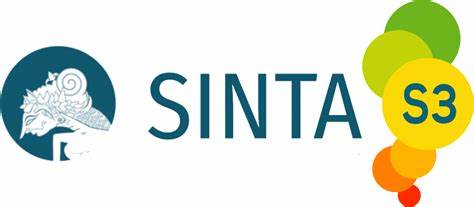EFL UNDERGRADUATE STUDENTS’ GENDER DIFFERENCES IN THE UTILIZATION OF AI-ASSISTED WRITING APPLICATIONS
Keywords:
Aplikasi Penulisan Berbantuan AI, Perbedaan Gender, Persepsi SiswaAbstract
Artificial Intelligence (AI) has become a significant development in academic writing practices as it can aid undergraduate students in improving their writing skills. This study examines the gender differences in the usage and effectiveness of AI-assisted writing applications and students’ perceptions regarding the benefits and challenges of using these AI tools in academic writing. A mixed-methods approach was employed, combining quantitative data from questionnaires with qualitative insights derived from interviews with 54 students (27 female and 27 male). The findings reveal no significant gender differences when using AI-enhanced writing applications. Both male and female students reported similar satisfaction with the tools, including ease of use, accessibility, and effectiveness in improving their writing. However, nuanced variations in confidence levels and usage patterns emerged. Furthermore, students expressed benefits, highlighting their utility in improving grammar, vocabulary, and overall writing proficiency. Concerns about over-reliance and potential impact on creativity and critical thinking were also noted. The findings also suggest a need for tailored pedagogical strategies incorporating AI while promoting independent thought and creativity.
References
Ali, Z. (2020). Artificial Intelligence (AI): A Review of its Uses in Language Teaching and Learning. IOP Conference Series: Materials Science and Engineering, 769(1). https://doi.org/10.1088/1757-899X/769/1/012043
Ary, D., Jacobs, L. C., & Sorensen, C. (2010). Introduction to Research in Education.
Burkhard, M. (2022). Student Perceptions of AI-Powered Writing Tools: Towards Individualized Teaching Strategies. https://www.grammarly.com/plagiarism-checker
Chang, T.-S., Li, Y., Huang, H.-W., & Whitfield, B. (2021). Exploring EFL students’ writing performance and their acceptance of AI-based automated writing feedback. Proceedings of the 2021 2nd International Conference on Education Development and Studies, 31–35.
Charrouf, A. (2015). Improving EFL Students’ Writing Skill through a Directed Blog Case of Students at Mohamed Khider University of Biskra A dissertation submitted in partial fulfilment for the requirements for The Master of Arts Degree in Language Sciences.
Creswell, J. W., & Creswell, J. D. (2023). Sixth Edition - Research Design.
Fauziah, Z., & Minarti, S. (2023). Artificial Intelligence-Assisted Writing Application for Improving Writing Skills of Islamic Education Students. In Agustus Tahun (Vol. 13, Issue 2).
Fitria, T. N. (2021). Grammarly as AI-powered English writing assistant: Students’ alternative for writing English. Metathesis: Journal of English Language, Literature, and Teaching, 5(1), 65–78.
Herwanto, W. H., Setiawan, S., & Munir, A. (2024). What Lies Beneath English Major Students’ Attitudes towards ChatGPT for Academic Writing: A TAM Perspective? Equilibrium: Jurnal Pendidikan, 12(2), 152–159.
Huang, H. W., Li, Z., & Taylor, L. (2020). The Effectiveness of Using Grammarly to Improve Students’ Writing Skills. ACM International Conference Proceeding Series, 122–127. https://doi.org/10.1145/3402569.3402594
Hwang, W.-Y., Nurtantyana, R., Purba, S. W. D., Hariyanti, U., Indrihapsari, Y., & Surjono, H. D. (2023). AI and recognition technologies to facilitate English as foreign language writing for supporting personalization and contextualization in authentic contexts. Journal of Educational Computing Research, 61(5), 1008–1035.
Karsenti, T. (2019). The urgent need to prepare teachers for tomorrow’s schools.
Kurniati, E. Y., & Fithriani, R. (2022). Post-Graduate Students’ Perceptions of Quillbot Utilization in English Academic Writing Class. Journal of English Language Teaching and Linguistics, 7(3), 437. https://doi.org/10.21462/jeltl.v7i3.852
Le Phan, T. N. (2023). Students’ perceptions of the AI technology application in English writing classes. Proceedings of the AsiaCALL International Conference, 4, 45–62.
Lee, Y.-J., Davis, R. O., & Lee, S. O. (2024). University students’ perceptions of artificial intelligence-based tools for English writing courses. Online Journal of Communication and Media Technologies, 14(1), e202412.
Lindawati, N., Jabu, B., & Baa, S. (2022). Students’ Perception on the Use of WhatsApp in Learning EFL during Covid 19 at Remote Area.
Nguyen, P. H., & Dieu, N. B. (2024). An investigation into third-year Elt students’ perceptions of using Chatgpt as an Ai writing-assistant tool: a case study in Vietnam. International Journal of Arts Humanities and Social Sciences Studies, 9(5).
Phan, T. N. Le. (2023). Students’ Perceptions of the AI Technology Application in English Writing Classes. Proceedings of the AsiaCALL International Conference, 4, 45–62. https://doi.org/10.54855/paic.2344
Putra, M. (2023). AI Writing Correction Tools: Teachers and Students’ Perception. Jurnal Tatsqif, 21(1), 35–66. https://doi.org/10.20414/jtq.v21i1.7963
Rahma Hakiki, G. N. (2021). Perception of EFL Students on the Use Grammarly Application in Writing Class. EDUVELOP, 4(2), 99–106. https://doi.org/10.31605/eduvelop.v4i2.891
Rahman, N. A. A., Zulkornain, L. H., & Hamzah, N. H. (2022). Exploring artificial intelligence using automated writing evaluation for writing skills. Environment-Behaviour Proceedings Journal, 7(SI9), 547–553.
TOBOULA, C. M. Z. (2023). Exploring the Impact of AI-powered Collaborative and Interactive NLP Apps on EFL Teaching in the Post-COVID-19 Era. International Journal on Cybernetics & Informatics, 12(2), 171–193. https://doi.org/10.5121/ijci.2023.120213
Utami, S. P. T., Andayani, Winarni, R., & Sumarwati. (2023). Utilization of artificial intelligence technology in an academic writing class: How do Indonesian students perceive? Contemporary Educational Technology, 15(4). https://doi.org/10.30935/cedtech/13419
САҚ, С. Т. (2024). Utilizing Artificial Intelligence in English Language Education for Tourism Students. Bulletin of the International University of Tourism And Hospitality, II (4), 102–113.
Downloads
Published
Issue
Section
License

This work is licensed under a Creative Commons Attribution-ShareAlike 4.0 International License.
The author is responsible for acquiring the permission(s) to reproduce any copyrighted figures, tables, data, or text that are being used in the submitted paper. Authors should note that text quotations of more than 250 words from a published or copyrighted work will require grant of permission from the original publisher to reprint. The written permission letter(s) must be submitted together with the manuscript.




